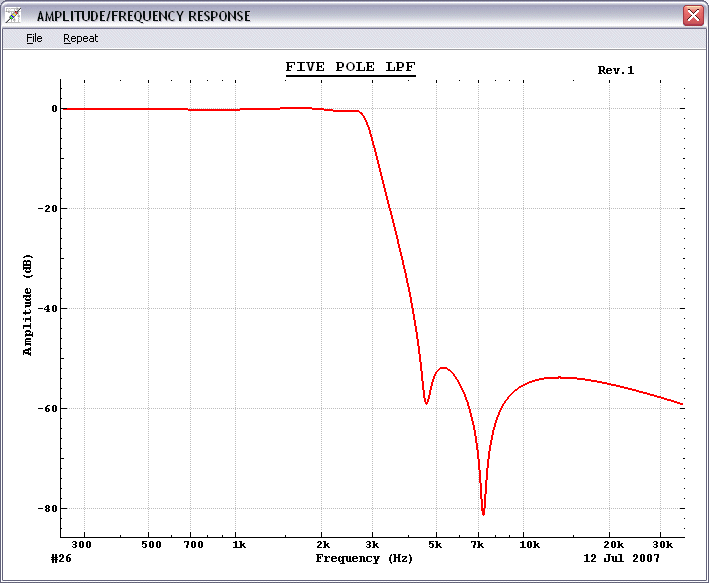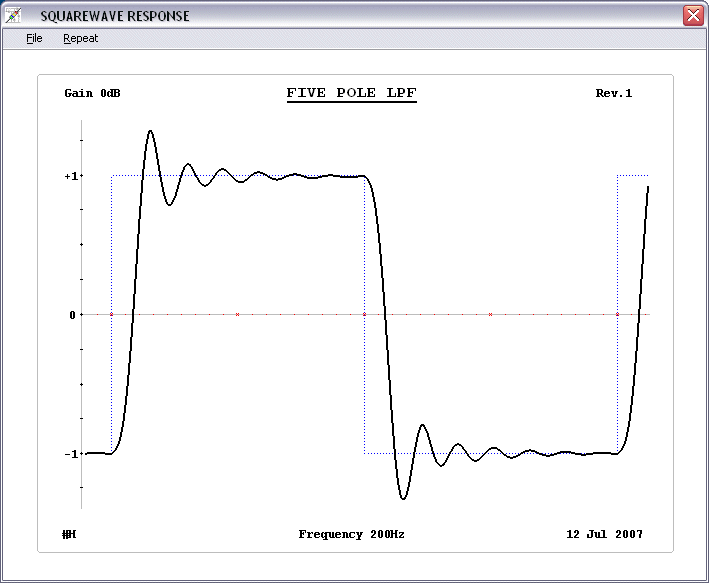CIRSIM is
the Windows version of the simulation program. It can be used
to calculate the steady state performance of circuits
containing up to 100 nodes with any combination of resistors,
capacitors, inductors, centre-tapped transformers, mutual
inductors, transistors (bipolar and FET), op-amps and
thermionic valves. The output displays the gain (in dB),
phase shift and the input and output impedances of the
network at any given frequency. Component and frequency
values may be input using the symbols p,n,u,m,k,M,G and T as
multipliers. The circuit values are stored in a text file on
disk - values may be modified at any time using the program
editor, extra components and nodes can be added or deleted
and input and output nodes redefined. A listing of the
component and node values for each circuit may be printed
out. A demonstration version
of the program handling a maximum of 6 nodes can be
downloaded from this site (see below).
Comprehensive graph
plotting facilities are also included, with the facility to
superimpose amplitude / frequency response plots. Fiftytwo
predefined frequency scales extending from 0.03Hz to 3GHz
over a range of 1, 2, 3, 5 or 6 decades are provided together
with the facility for a user defined frequency scale covering
any range. The amplitude scales may be set as required.
Typical results in the screenshot below show the amplitude
response of a five pole low pass filter :-

And the following plot
shows the corresponding squarewave response which exhibits
ringing at around the filter cut off frequency :-

CIRSIM
can be used to calculate the response of any linear analogue
(analog) circuit, such as audio, video, i.f and r.f.
amplifiers, active and passive filters, matching networks,
etc. It can be used to evaluate the effectiveness of
decoupling components and the stability criteria of
oscillators. Detailed documentation is included together with
many circuit examples, including a transmission line, active
and passive filters, various feedback amplifiers, TV IF
amplifier, a cascode circuit, a gyrator, a mutually coupled
tuned circuit, Quad 303 audio amplifier, Williamson valve
power amplifier, a Wien bridge oscillator, a quartz crystal
equivalent circuit, Baxandall audio tone control, a
loudspeaker crossover network and a multiband graphic
equalizer.
Minimum hardware
requirements for this latest version of the program are a 386
compatible PC (with coprocessor) and running Windows
9x/Me/NT/XP/Vista with SVGA graphics. Comprehensive testing
has been carried out on a range of IBM compatible PCs and a
range of popular printers. Comparison of the results obtained
using SPICE to analyse some of the circuits shows exact
agreement with CIRSIM.
ACNET
is the DOS version of the simulation program. It performs in
the same way as CIRSIM but is slower in
operation and is limited to a maximum of 50 nodes. It will
function on any IBM 286 (or above) compatible PC. The
graphical output supports Epson (9 and 24 pin), IBM and HP
DeskJet printers. Both programs are EDA - Electronic Design
Automation - products.